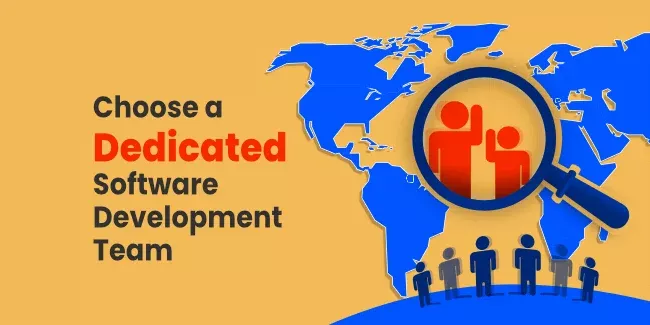Dedicated Team Model: Definition, Pros, and Cons for Your Project
According to a recent report by “Grandview Research”, the global software development outsourcing market is projected to experience a steady annual growth rate of 7.7% from 2021 to 2027, reaching a remarkable revenue of $937 billion within six years. As a result, many companies are turning to the dedicated team model as a preferred engagement approach.
In this article, we will delve into the advantages and disadvantages of the dedicated project team structure. We will explore the reasons why hiring dedicated developers may be beneficial for your business, and provide valuable tips to help you select the best ones for your specific needs.
 Source: Accelerance
Source: Accelerance
1. What Is A Dedicated Team Model?
The Dedicated Team model (DTM) is a remote team that focuses on a project with the goal of reducing the product’s time to market and improving the client’s business processes. Unlike other models, the DTM operates as a separate unit with its own framework and management, providing a level of independence from the client.

Other common IT outsourcing models include the fixed-price and time and material approaches:
1.1 Fixed-Price Model:
In a fixed-price contract, the payment amount is predetermined and does not depend on the resources used or time expended. This model is suitable for short-term or medium-sized projects with clear requirements and deadlines, or when developing a Minimum Viable Product (MVP). However, it can complicate risk management and limit control over the development process. It also requires thorough documentation of requirements and deadlines, resulting in a longer preparation period.
1.2 Time and Material Model:
The time and material model involves payment based on the time and effort spent on development. It offers flexibility and can adapt to changes throughout the project. Typically, customers make monthly payments that reflect the actual work performed. However, accurately estimating the project budget can be challenging, particularly in startups where comprehensive information may be lacking. Additionally, the project timeline for delivering the final product version can be uncertain due to the evolving scope of the project.
It’s important to consider these different models and their advantages and disadvantages when selecting an outsourcing approach that best suits your project requirements, budget constraints, and risk management preferences. The Dedicated Team model offers flexibility, expertise, and focus on the project, while the fixed-price and time and material models provide alternative options based on project size, clarity of requirements, and budget flexibility.
| Criteria | Dedicated Team | Fixed Price | Time and Material |
| When to choose |
|
|
|
| Budget and timeframe | Flexible | Fixed | Flexible |
| Control over the process | Full | Little | Significant |
| Methodology | Agile | Waterfall | Agile |
| Requirements | Changing | Strictly defined | Changing |
2. How Does It Work?
This model can be effectively explained by following a series of steps:
- Step1: Customer Requirement Outline: The first step entails the customer clearly defining their specific desires and requirements. This involves determining the number of employees needed for the project and identifying the necessary technical skills they should possess.
- Step 2: Once the customer’s requirements are established, the provider assembles a dedicated team that precisely matches the project requirements. Collaboratively, the team and the client agree on the workload and project specifications within a specified timeframe.
- Step 3: After forming the dedicated team, they commence their work during regular hours. The team consists of experts who bring their skills and expertise to contribute to the project’s success.
- Step 4: Client Project Control: Throughout the project, the client retains complete management control. They oversee and manage both the project and the dedicated team, ensuring that their requirements are met and that the project progresses according to their expectations.
- Step 5: Focused Results Delivery: The dedicated team’s primary focus is on providing exceptional results. They concentrate their services and efforts on delivering the best possible outcome, aligning with the client’s goals and aspirations.
By following these steps, this model ensures effective communication, collaboration, and client satisfaction throughout the project’s lifecycle.
3. Why Outsource Your Software Development Project to a Third Party?

Companies are encouraged to enable remote work for their in-house software engineers. In-housers now have to adopt a new model of work that outsource specialists have already mastered. The ability to work remotely and efficiently is essential as never before.
Here are some reasons why outsourcing can be advantageous:
- Access to Expertise: Outsourcing allows you to tap into a vast pool of specialized expertise and technical skills that may not be readily available in-house. You can leverage the knowledge and experience of professionals who are well-versed in the latest technologies and industry best practices.
- Cost Efficiency: Outsourcing software development can often be more cost-effective compared to hiring and maintaining an in-house team. You can save on expenses such as salaries, benefits, infrastructure, and training. Additionally, outsourcing providers often operate in regions with lower labor costs, providing cost advantages without compromising quality.
- Focus on Core Competencies: By outsourcing non-core activities like software development, you can free up internal resources and concentrate on your organization’s core competencies and strategic initiatives. Outsourcing allows you to delegate tasks to experts, enabling your team to focus on what they do best.
- Increased Scalability: Outsourcing provides scalability and flexibility to adjust resources according to project demands. You can easily ramp up or down the team size based on workload fluctuations, without the need for lengthy recruitment processes or dealing with workforce management challenges.
- Faster Time to Market: Third-party software development providers often have well-established development processes, tools, and methodologies in place. They can accelerate the development timeline, ensuring faster time to market for your products or services. Their experience and efficiency can help you gain a competitive edge.
- Mitigation of Risk: Outsourcing can help mitigate certain risks associated with software development projects. Reputable outsourcing providers have extensive experience handling various projects, and they can apply their knowledge to manage risks effectively. They often have robust backup and disaster recovery plans in place to ensure business continuity.
- Access to Advanced Technologies: Outsourcing partners frequently invest in the latest technologies and infrastructure to deliver high-quality software solutions. By outsourcing, you can leverage these advancements without making substantial investments on your own. This access to cutting-edge technologies can enhance the quality and capabilities of your software product.
- Scalable Support and Maintenance: Outsourcing partners typically provide ongoing support and maintenance services for the software they develop. This ensures that your software remains up-to-date, secure, and functional even after the initial development phase. Outsourcing providers have the expertise to handle bug fixes, updates, and enhancements efficiently.
- Global Perspective and Market Insights: Collaborating with a third-party provider brings a global perspective to your software development project. They can offer insights into diverse markets and user expectations, helping you tailor your software to specific target audiences. This global perspective can contribute to the overall success and market competitiveness of your product.
- Focus on Innovation: With outsourcing taking care of software development, your internal team can allocate more time and resources to focus on innovation and strategic initiatives. You can foster a culture of innovation within your organization, exploring new ideas and driving business growth while leaving the development execution to trusted outsourcing partners.
When deciding to outsource software development, it’s essential to carefully choose a reliable and competent outsourcing partner, ensure clear communication, establish mutual goals and expectations, and maintain an effective collaboration throughout the project lifecycle.
4. The Advantages and Disadvantages of a Dedicated Team: Weighing the Pros and Cons
4.1 Advantages of Dedicated Teams

A dedicated team has several advantages that can contribute to the success of a project or organization. Here are some key advantages of a dedicated team:
- Expertise and Specialization:
When you have a dedicated team, each member can specialize in specific areas or skills relevant to the project. This specialization allows team members to become experts in their respective domains, leading to higher quality work and increased efficiency.
- Commitment and Focus:
A dedicated team is solely focused on a particular project or set of tasks. As a result, team members have a higher level of commitment and are more likely to be invested in the project’s success. They are not distracted by competing priorities or divided attention, leading to improved productivity and outcomes.
- Communication and Collaboration:
Dedicated teams often work closely together, fostering effective communication and collaboration. With ongoing interaction and familiarity among team members, communication barriers are minimized, and knowledge sharing becomes more efficient. This leads to better coordination, problem-solving, and decision-making within the team.
- Flexibility and Agility:
Dedicated teams are typically more flexible and agile in responding to changing project requirements or priorities. They can quickly adapt to new challenges, adjust strategies, and allocate resources accordingly. This flexibility allows the team to be responsive and proactive in meeting project goals, even in dynamic and fast-paced environments.
- Ownership and Accountability:
Team members in a dedicated team often have a sense of ownership and accountability for their work. They feel responsible for the outcomes and take pride in delivering high-quality results. This sense of ownership can drive motivation, innovation, and a proactive approach to problem-solving.
- Knowledge Retention:
A dedicated team provides continuity and knowledge retention within the project or organization. As team members work together over an extended period, they accumulate valuable domain knowledge and experience. This accumulated knowledge can be leveraged to improve processes, avoid repeating mistakes, and drive continuous improvement.
- Reduced Communication Overhead:
In larger organizations or projects involving multiple teams, having a dedicated team can streamline communication. Instead of coordinating with various individuals or teams, stakeholders can interact directly with the dedicated team, reducing communication overhead and potential miscommunication.
- Long-Term Collaboration:
A dedicated team often works together over an extended period, allowing team members to develop a strong working relationship. This long-term collaboration promotes a better understanding of each other’s strengths, weaknesses, and work preferences, leading to smoother workflows and increased efficiency.
Overall, a dedicated team offers a range of benefits, including specialized expertise, increased commitment, effective communication, flexibility, accountability, knowledge retention, streamlined processes, and stronger collaboration. These advantages can significantly contribute to the successful completion of projects and the achievement of organizational goals.
4.2 Disadvantages of Dedicated Teams

While dedicated teams offer numerous advantages, it’s important to consider potential disadvantages as well. Here are some disadvantages associated with dedicated teams:
- Cost:
Maintaining a dedicated team can be more expensive than other team structures. Having a team dedicated solely to a specific project or task requires continuous funding, including salaries, benefits, training, and infrastructure. This cost may not be justifiable for smaller or short-term projects with limited budgets.
- Lack of Flexibility:
While dedicated teams offer flexibility and agility, they can also become less flexible in certain situations. If a project’s requirements or priorities change drastically, the specialized skills of the dedicated team members may not align with the new direction. Adapting to unforeseen circumstances or transitioning team members to other projects can be challenging and time-consuming.
- Limited Perspective:
A dedicated team’s specialization and focus on a specific project or task can sometimes result in a narrow perspective. Team members may become too immersed in their particular domain, potentially overlooking alternative approaches or innovative ideas from outside sources. This limited perspective could hinder creativity and hinder the ability to explore new solutions.
- Dependency and Single Point of Failure:
Relying heavily on a dedicated team can create a dependency on specific individuals or a small group of experts. If a key team member leaves or becomes unavailable due to illness, vacation, or other reasons, it can disrupt the project’s progress and lead to delays. The team may also become a single point of failure, as knowledge and expertise are concentrated within a limited number of individuals.
- Difficulty Scaling:
Dedicated teams are often designed for a specific project scope or size. If the project expands or additional resources are required, scaling the dedicated team can be challenging. Hiring and integrating new team members might disrupt the existing dynamics and require time for onboarding and knowledge transfer.
- Limited Cross-Pollination:
In a dedicated team, members primarily collaborate with each other and may have limited interaction with professionals from other departments or disciplines. This lack of cross-pollination can hinder the exchange of ideas, diversity of perspectives, and interdisciplinary innovation. It may also restrict the team’s ability to leverage broader organizational knowledge and expertise.
- Risk of Groupthink:
Groupthink refers to the tendency for a cohesive group to prioritize consensus over critical thinking. In a dedicated team with a strong sense of camaraderie and shared goals, there’s a risk of suppressing dissenting opinions or alternative viewpoints. This can lead to less effective decision-making and reduced creativity.
- Sustaining Motivation:
While dedication and commitment are generally considered advantages, sustaining high motivation levels within a dedicated team can be a challenge. Over time, team members may experience burnout or reduced enthusiasm, especially if the project faces setbacks or extended timelines. Maintaining morale and motivation requires continuous effort from team leaders and organizations.
It’s important to consider these disadvantages alongside the advantages when deciding whether a dedicated team is suitable for a particular project or organization. Each context is unique, and understanding the trade-offs can help in making an informed decision.
5. Reasons Why You Need a Dedicated Development Team
If you’re still unsure whether a dedicated team model is the right choice for your project, consider the following checklist. If most of the statements below resonate with your situation, it’s highly likely that a dedicated team is a suitable option for you.

5.1 Lack of Required Experience and Expertise:
Are your employees equipped with the necessary experience and expertise to undertake the project? If not, seeking assistance from an external dedicated team can provide the required skills and knowledge.
5.2 Large-Scale Project:
If your project is substantial, involving multiple tasks and extensive requirements, relying solely on your internal workforce may prove challenging to successfully accomplish the project goals.
5.3 Long-Term Project:
Whether you’re a startup or an established company, chances are you’ll undertake additional projects in the future. Managing multiple projects simultaneously can strain efficiency, making a dedicated team an advantageous solution.
5.4 Need for Flexibility:
Projects often undergo changes, leading to new goals and requirements. The dedicated team model offers built-in flexibility, allowing the project to adapt and evolve as needed.
5.5 Increased Oversight of Day-to-Day Process:
If you value staying informed about the project’s progress and want to maintain control over its day-to-day operations, a dedicated team provides transparency through progress-tracking tools and regular reports.
By considering these factors, you can evaluate whether a dedicated development team is the right fit for your project, enabling you to leverage external expertise, manage large-scale or long-term initiatives efficiently, and maintain control over the project’s progress and resources.
6. Where to find the Right Dedicated Team
Finding the right dedicated team for your project or organization requires careful consideration and a strategic approach. Here are some avenues where you can look for the right dedicated team:
6.1 In-House Employees:
If you already have a pool of talented employees within your organization, consider selecting individuals with the necessary skills and expertise to form a dedicated team. This approach can ensure continuity, as these employees are familiar with the organization’s culture, processes, and goals.
6.2 Referrals and Recommendations:
Seek recommendations from colleagues, industry peers, or professional networks. Referrals often lead to finding reliable and skilled professionals who have a proven track record. Leverage your network to find individuals or teams that have the expertise and experience relevant to your project.
6.3 Freelance Platforms and Online Marketplaces:
There are numerous online platforms that connect businesses with freelancers or specialized teams. Websites like Upwork, Freelancer, and Toptal allow you to browse through profiles, portfolios, and reviews to find dedicated professionals or teams that match your requirements. These platforms often provide tools for managing projects and facilitating communication.
6.4 Professional Associations and Events:
Industry-specific professional associations and conferences are great places to network and connect with experts in the field. Attend relevant events, participate in panel discussions, or engage in networking sessions to meet potential dedicated team members. These associations often have directories or online platforms where you can find professionals or teams specializing in your industry.
6.5 Dedicated Team Service Providers:
Some companies specialize in providing dedicated teams for specific domains or technologies. These service providers have pre-formed teams with diverse skill sets and can offer flexibility in terms of team size and project duration. Research and reach out to these providers to discuss your requirements and explore the possibility of collaboration.
6.6 Recruitment Agencies:
Recruitment agencies can help you find suitable candidates for dedicated team positions. They have access to a wide talent pool and can assist with the screening, shortlisting, and interviewing process. Provide the agency with clear criteria and specifications for your dedicated team, and they can assist in finding the right professionals.
6.7 Online Communities and Forums:
Participating in relevant online communities, forums, or social media groups can help you connect with professionals who are passionate about specific topics or technologies. Engage in discussions, seek recommendations, and post your requirements to attract individuals or teams with the right expertise.
6.8 Company Websites and Job Boards:
Many professionals and dedicated teams showcase their work, portfolios, and availability on their own websites or through job boards. Monitor industry-specific job boards or visit company websites directly to find individuals or teams advertising their services or availability.
Remember to thoroughly evaluate potential dedicated team members based on their expertise, experience, communication skills, portfolio, and cultural fit. Conduct interviews, review past work, and check references to ensure they align with your project’s requirements and goals.
7. Tips for Choosing an Outsourcing Software Development Team

Choosing the right outsourcing software development team is crucial for the success of your project. Here are some tips to consider when selecting an outsourcing partner:
7.1 Define Your Project Requirements:
Clearly define your project requirements, including the scope, objectives, timeline, budget, and expected deliverables. Having a well-defined project plan will help you communicate your needs effectively to potential outsourcing partners.
7.2 Determine the Required Expertise:
Identify the specific technical skills, programming languages, frameworks, and tools required for your project. Look for outsourcing teams with experience and expertise in those areas. Assess their portfolios, case studies, and client testimonials to gauge their capabilities.
7.3 Evaluate Relevant Experience:
Look for outsourcing teams that have relevant experience in developing similar software solutions or working on projects within your industry. Their domain knowledge and understanding of specific industry challenges can be valuable in delivering a successful product.
7.4 Check Reputation and Track Record:
Research the outsourcing team’s reputation and track record. Look for reviews, ratings, and client feedback. Request references and reach out to their past clients to inquire about their experience, the team’s performance, and the quality of their work.
7.5 Assess Communication and Language Skills:
Effective communication is essential for successful outsourcing collaboration. Evaluate the outsourcing team’s communication skills, both written and verbal. Assess their proficiency in the language(s) you prefer to communicate in, as language barriers can hinder collaboration and understanding.
7.6 Consider Cultural Compatibility:
Cultural compatibility plays a significant role in outsourcing success. Look for teams that are accustomed to working with clients from your region or have experience adapting to different work cultures. Cultural alignment can contribute to smoother communication, collaboration, and overall project management.
7.7 Quality Assurance Processes:
Inquire about the outsourcing team’s quality assurance processes and methodologies. Assess their approach to testing, bug fixing, and code review. A dedicated focus on quality will help ensure that the final product meets your standards and requirements.
7.8 Security and Intellectual Property Protection:
Ensure that the outsourcing team follows strict security protocols to protect your sensitive data and intellectual property. Discuss confidentiality agreements, non-disclosure agreements, and data protection measures to safeguard your information throughout the development process.
7.9 Project Management and Transparency:
Understand how the outsourcing team manages projects, tracks progress, and ensures transparency. Look for teams that provide regular progress reports, have established project management methodologies, and offer access to project management tools or platforms for better visibility into the development process.
7.10 Scalability and Flexibility:
Consider the outsourcing team’s scalability and flexibility to accommodate changing project requirements or fluctuations in workload. Assess their ability to ramp up or down resources as needed and their willingness to accommodate your evolving needs.
7.11 Cost and Value:
While cost is an important factor, it should not be the sole determining factor. Consider the overall value provided by the outsourcing team in terms of expertise, quality, communication, and long-term collaboration potential. Evaluate their pricing structure and ensure it aligns with your budget and expectations.
7.12 Start with a Pilot Project:
Consider starting with a smaller pilot project before committing to a long-term engagement. This allows you to assess the outsourcing team’s capabilities, collaboration dynamics, and compatibility with your organization before scaling up the project.
By considering these tips and conducting thorough due diligence, you can increase the likelihood of choosing an outsourcing software development team that best fits your project’s needs and sets the stage for a successful partnership.
8. Dedicated Teams at ONext Digital

ONext Digital has extensive expertise in establishing and managing dedicated teams for businesses of all sizes, ranging from startups to large corporations. The success of a dedicated team largely hinges on the service provider’s ability to nurture talent and provide a conducive infrastructure and environment. Here’s why ONext Digital is the ideal choice for your dedicated team needs:
- Requirement Gathering and Team Setup: We have perfected a process for gathering precise requirements from our clients and configuring a dedicated team tailored to those requirements. This ensures that the team composition aligns perfectly with the project’s needs, setting the stage for success.
- Transparent and Smooth Development Process: We prioritize transparency and aim for a seamless development process. Our project management team and business analysts maintain continuous communication with the client, ensuring a clear understanding of project goals and requirements. This collaborative approach minimizes problems and enhances project efficiency.
- Scalability: We understand that project requirements may change over time. As such, we offer the flexibility to easily scale up our dedicated team based on our clients’ requests. Whether you need additional resources or specialized expertise, we can quickly adapt to meet your evolving needs.
By choosing ONEXT DIGITAL, you can expect a comprehensive and tailored approach to establishing and managing your Dedicated Team. We excel in gathering precise requirements, maintaining transparency throughout the development process, and providing scalability to accommodate your project’s changing demands.
9. Conclusion
For 10+ years, ONext Digital has been a remote-friendly company, catering to customers across eight different time zones. Our Outsourcing services have enabled businesses worldwide to save significant costs and collaborate with us seamlessly from remote locations.
We are well-equipped and experienced in working online, ensuring smooth operations irrespective of the prevailing epidemiological situation. Our remote human resource management practices prioritize excellent communication with clients and timely delivery of project artifacts.
If you find yourself uncertain about which model—dedicated team, fixed-price, or time and material—would best benefit your project, don’t hesitate to reach out to ONext Digital. We are here to discuss all the intricate details and provide guidance tailored to your specific needs.
|Read more:
Ultimate Guide To Hire Dedicated WordPress Developers For Your Project- Update 2023




